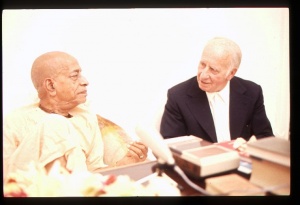CC Madhya 8.28 (1975): Difference between revisions
(Vanibot #0027: CCMirror - Mirror CC's 1996 edition to form a basis for 1975) |
(Vanibot #0020: VersionCompareLinker - added a link to the Version Compare feature) |
||
| Line 2: | Line 2: | ||
<div style="float:left">'''[[Sri Caitanya-caritamrta (1975)|Śrī Caitanya-caritāmṛta (1975)]] - [[CC Madhya (1975)|Madhya-līlā]] - [[CC Madhya 8 (1975)|Chapter 8: Talks Between Śrī Caitanya Mahāprabhu and Rāmānanda Rāya]]'''</div> | <div style="float:left">'''[[Sri Caitanya-caritamrta (1975)|Śrī Caitanya-caritāmṛta (1975)]] - [[CC Madhya (1975)|Madhya-līlā]] - [[CC Madhya 8 (1975)|Chapter 8: Talks Between Śrī Caitanya Mahāprabhu and Rāmānanda Rāya]]'''</div> | ||
<div style="float:right">[[File:Go-previous.png|link=CC Madhya 8.27 (1975)|Madhya-līlā 8.27]] '''[[CC Madhya 8.27 (1975)|Madhya-līlā 8.27]] - [[CC Madhya 8.29 (1975)|Madhya-līlā 8.29]]''' [[File:Go-next.png|link=CC Madhya 8.29 (1975)|Madhya-līlā 8.29]]</div> | <div style="float:right">[[File:Go-previous.png|link=CC Madhya 8.27 (1975)|Madhya-līlā 8.27]] '''[[CC Madhya 8.27 (1975)|Madhya-līlā 8.27]] - [[CC Madhya 8.29 (1975)|Madhya-līlā 8.29]]''' [[File:Go-next.png|link=CC Madhya 8.29 (1975)|Madhya-līlā 8.29]]</div> | ||
{{CompareVersions|CC|Madhya 8.28|CC 1975|CC 1996}} | |||
{{RandomImage}} | {{RandomImage}} | ||
==== TEXT 28 ==== | ==== TEXT 28 ==== | ||
| Line 11: | Line 10: | ||
<div class="verse"> | <div class="verse"> | ||
:ei-mata vipra-gaṇa bhāve mane mana | :ei-mata vipra-gaṇa bhāve mane mana | ||
:vijātīya loka dekhi, prabhu kaila | :vijātīya loka dekhi, prabhu kaila saṁvaraṇa | ||
</div> | </div> | ||
| Line 18: | Line 17: | ||
<div class="synonyms"> | <div class="synonyms"> | ||
ei-mata—in this way; vipra-gaṇa—all the brāhmaṇas; bhāve—think; mane mana—within their minds; vijātīya loka—outside people; dekhi—seeing; prabhu—Lord Caitanya Mahāprabhu; kaila—did; | ei-mata—in this way; vipra-gaṇa—all the brāhmaṇas; bhāve—think; mane mana—within their minds; vijātīya loka—outside people; dekhi—seeing; prabhu—Lord Caitanya Mahāprabhu; kaila—did; saṁvaraṇa—restraining. | ||
</div> | </div> | ||
| Line 32: | Line 31: | ||
<div class="purport"> | <div class="purport"> | ||
Rāmānanda Rāya was intimately related to Śrī Caitanya Mahāprabhu; therefore he can be accepted as a sajātīya, a person within the intimate circle of the Lord. The brāhmaṇas, however, were followers of the Vedic rituals and were not able to have an intimate connection with Śrī Caitanya Mahāprabhu. Consequently they are called vijātīya-loka. In other words, they were not pure devotees. One may be a highly learned brāhmaṇa, but if he is not a pure devotee he is a vijātīya, an outcaste, one outside devotional | Rāmānanda Rāya was intimately related to Śrī Caitanya Mahāprabhu; therefore he can be accepted as a sajātīya, a person within the intimate circle of the Lord. The brāhmaṇas, however, were followers of the Vedic rituals and were not able to have an intimate connection with Śrī Caitanya Mahāprabhu. Consequently they are called vijātīya-loka. In other words, they were not pure devotees. One may be a highly learned brāhmaṇa, but if he is not a pure devotee he is a vijātīya, an outcaste, one outside devotional service-in other words, a nondevotee. Although Śrī Caitanya Mahāprabhu and Rāmānanda Rāya were embracing in ecstasy, the Lord restrained His transcendental emotions upon seeing the outsider brāhmaṇas. | ||
</div> | </div> | ||
Latest revision as of 20:12, 27 January 2020

A.C. Bhaktivedanta Swami Prabhupada
TEXT 28
- ei-mata vipra-gaṇa bhāve mane mana
- vijātīya loka dekhi, prabhu kaila saṁvaraṇa
SYNONYMS
ei-mata—in this way; vipra-gaṇa—all the brāhmaṇas; bhāve—think; mane mana—within their minds; vijātīya loka—outside people; dekhi—seeing; prabhu—Lord Caitanya Mahāprabhu; kaila—did; saṁvaraṇa—restraining.
TRANSLATION
While the brāhmaṇas were thinking in this way about the activities of Śrī Caitanya Mahāprabhu and Rāmānanda Rāya, Śrī Caitanya Mahāprabhu saw those outsiders and restrained His transcendental emotions.
PURPORT
Rāmānanda Rāya was intimately related to Śrī Caitanya Mahāprabhu; therefore he can be accepted as a sajātīya, a person within the intimate circle of the Lord. The brāhmaṇas, however, were followers of the Vedic rituals and were not able to have an intimate connection with Śrī Caitanya Mahāprabhu. Consequently they are called vijātīya-loka. In other words, they were not pure devotees. One may be a highly learned brāhmaṇa, but if he is not a pure devotee he is a vijātīya, an outcaste, one outside devotional service-in other words, a nondevotee. Although Śrī Caitanya Mahāprabhu and Rāmānanda Rāya were embracing in ecstasy, the Lord restrained His transcendental emotions upon seeing the outsider brāhmaṇas.